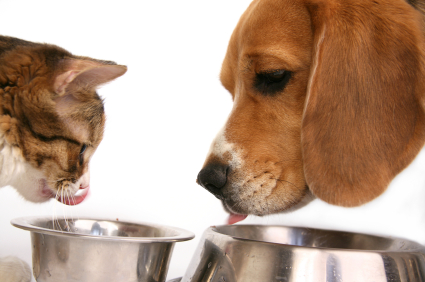I am asked frequently what and how much to feed dogs and cats. The answer depends on a variety of factors, and requires you, the pet parent to stay vigilant and educated.
According to Sharon Maguire at the Dog Breed Info Centre:
The first ingredient in your pet’s food should be a specified meat. Not a meat by-product, but the real thing. Dogs and cats were not meant to eat corn and wheat. If the first ingredient is a corn, wheat, meat by-product, bone meal or anything but a real, specified type of meat, steer clear. By-products are the leftovers, such as the eyes, hooves, skin, feathers and feet, which are not good for human consumption (unless the dog food specifically states otherwise.)
[related_content slugs=”pet-patter-identifying-body-language-in-dogs,show-me-your-ticks-spotting-and-removing-the-bulbous-little-demons,pet-patter-maintenance-exam-for-your-dog” description=”More Pet Patter” position=”right”]
A rendering plant is a processing operation where dead animals are recycled into products such as human food, pet food and industrial materials. They accept and collect animals condemned at slaughterhouses (diseased or dying livestock or poultry with ID tags still attached), slaughterhouse waste, road kill, euthanized cats and dogs from animal shelters and veterinarian offices (including their flea collars containing toxic pesticides, ID tags and a variety of powerful drugs), horses, dead animals from farmers, dead zoo animals, rats, mice, spoiled and unsold grocery store meat still in their plastic and Styrofoam wrappings, butcher shop trimmings that the butcher did not see as fit to sell and even used restaurant grease. The dead, destroyed, dying, disabled, diseased animals are classified in the trade as 4-D meat.
There are many uses for rendered products, but one of the widespread uses is to make low cost meats for dog and cat foods. This means your pet could be eating other dogs and cats as well as other 4-D animals not fit for human consumption.
How can you tell if your dog or cat food contains rendered products? Read the ingredients. If the food uses words such as “meat,” “animal” or “poultry” without specifying what type of meat or animal it is referring to, there is a good chance that it came from a rendering plant. Some of the ingredient lingo to watch for include Meat and Bone Meal ,Meat Meal, Bone Meal, Animal Fat, Tallow, Animal Digest, Digest, Poultry by-product meal, and Poultry by-products. If you have the stomach for it, you can find the precise ingredients for each of these here:
http://www.dogbreedinfo.com/care/renderingplantscatsdogs.htm
Do not rely on the feeding guidelines listed on dry food packages as they vary greatly and are only a rough guide. The proper amount is dependent on age, breed and activity level. For example an active 2 year old dog requires more food than a sedentary 8 year old. Treats and snacks are encouraged during a dog’s activity as it maintains energy, deflects hunger and prevents fatigue.
Dogs and cats can be as choosey as people when it comes to their foods, but your best bet is often making it yourself with fresh meat and vegetables. This requires trial and error to find what your animal likes best, and there are many good recipes available on the internet, as well as foods to avoid for both your cats and dogs. If you feel you do not have the time to do this, then please do take the time to do your research. Do not rely on your vet as far too many of them recommend inferior product. Read your labels. Read articles that are not written and/or funded by pet food companies. I have seen astonishing results once a pet’s diet is changed. Just like real, healthy food is good for us, so it is with them.
Good luck!
Fun fact: Dogs have about 1,700 taste buds. Humans have about 9000 taste buds, and cats have about 470.
—
Samantha Bennett has been a professional animal care giver for nearly four years, taking many critters under her wing from dogs and cats to hedgehogs, ferrets, birds and reptiles. She has cared for them in her own home and in the homes of others, and learned much through hands on experience. She understands the love pet parents feel for their animals, and their need to understand and help their furry charges. With this in mind, she has begun this column, a weekly space where she will give simple, useful directions, tips and information designed to keep animals safe and happy.
She can be reached at info@soinsmillepattes.com
